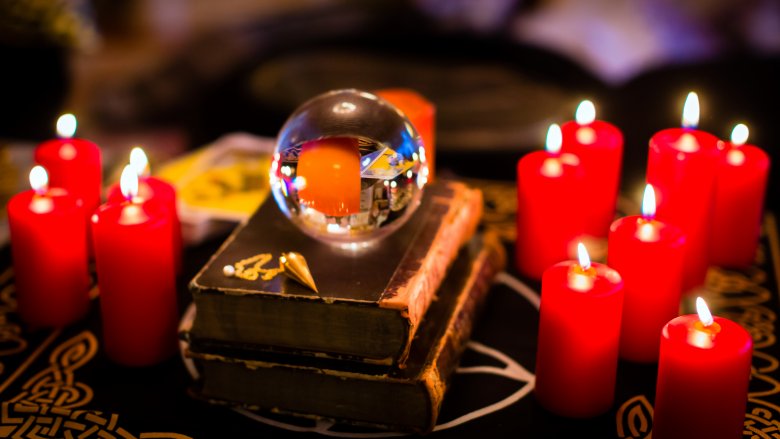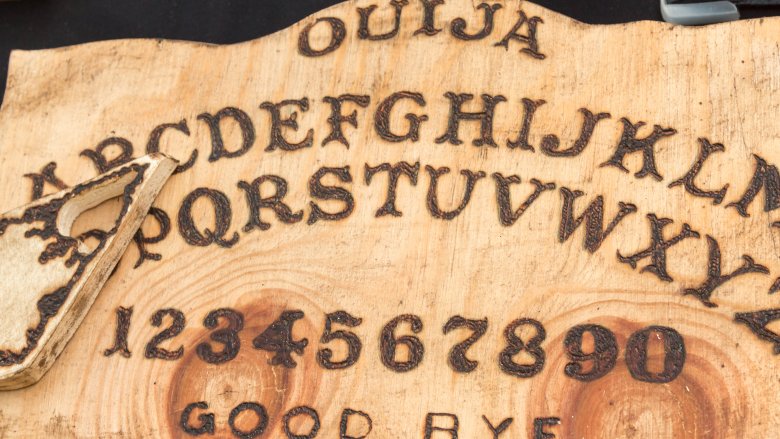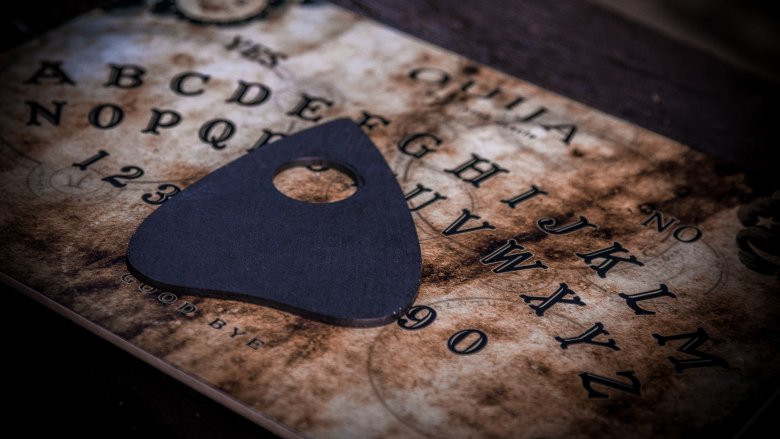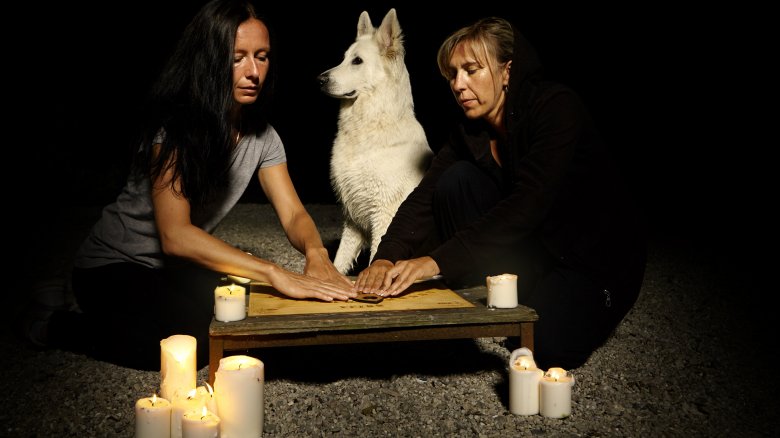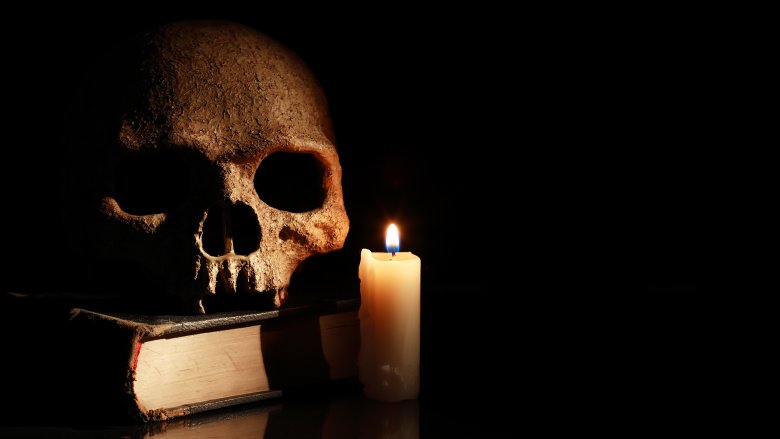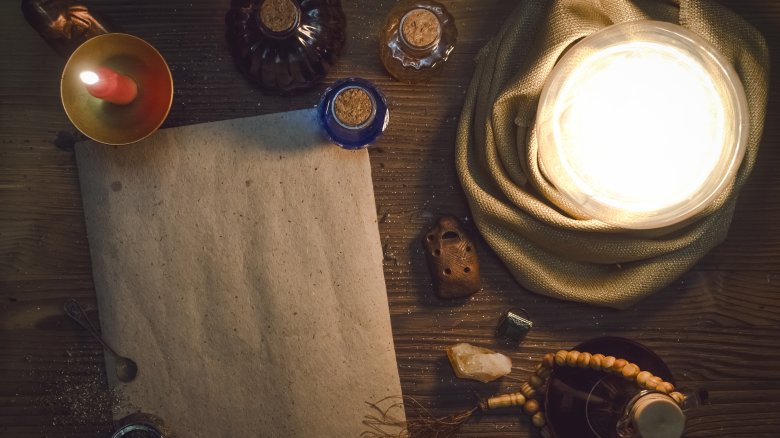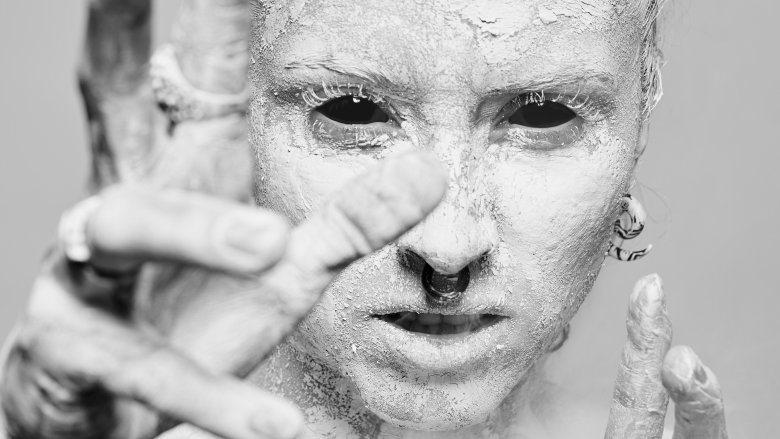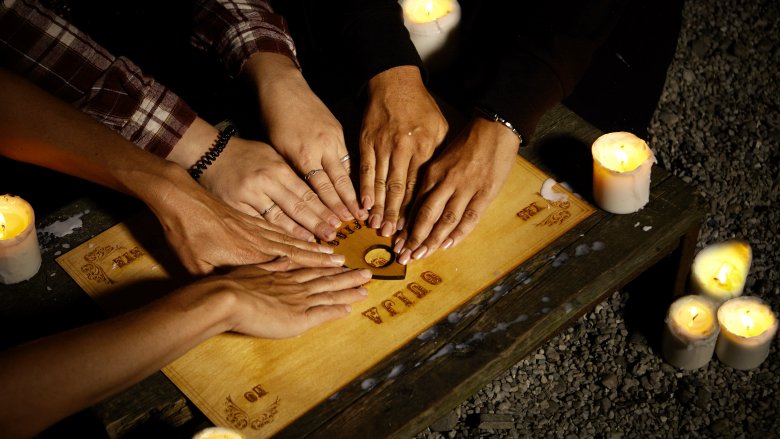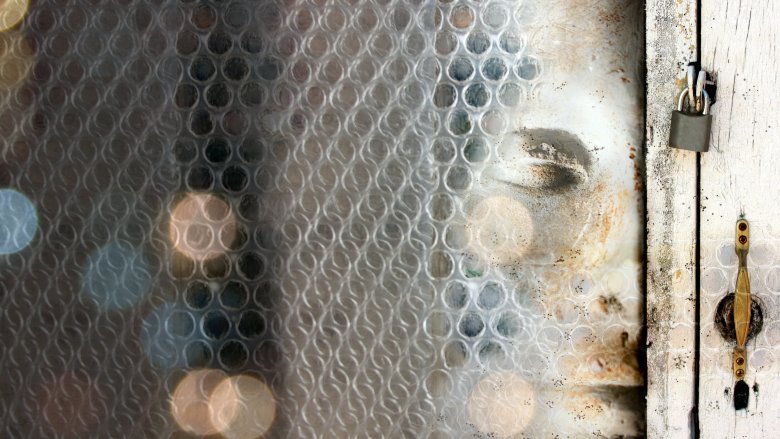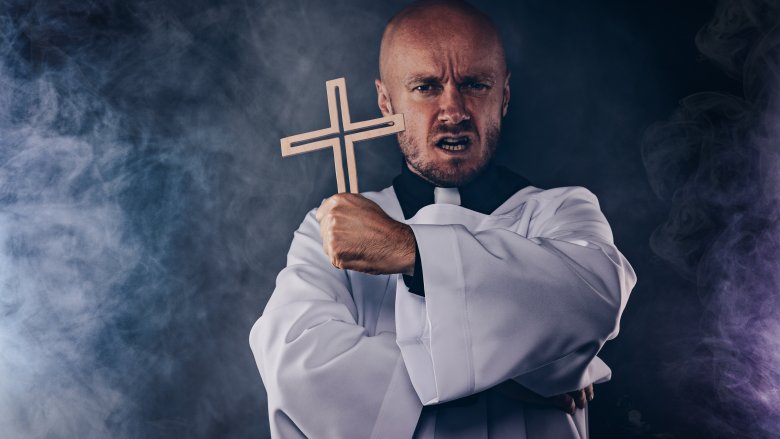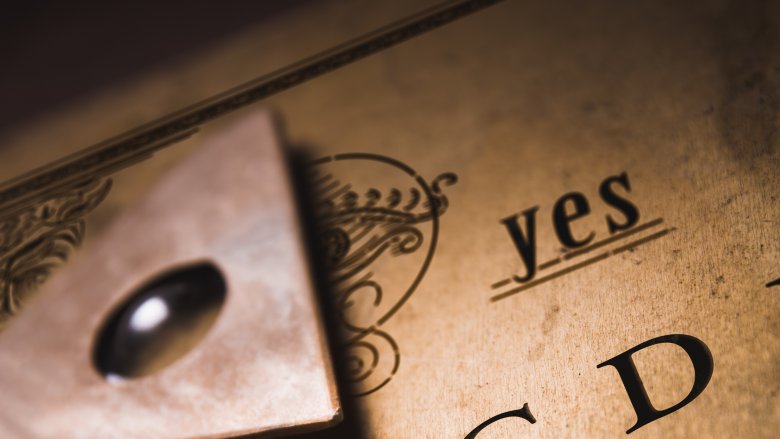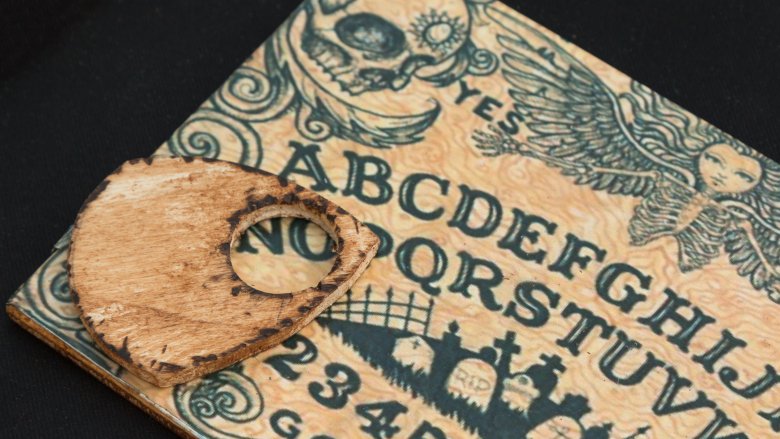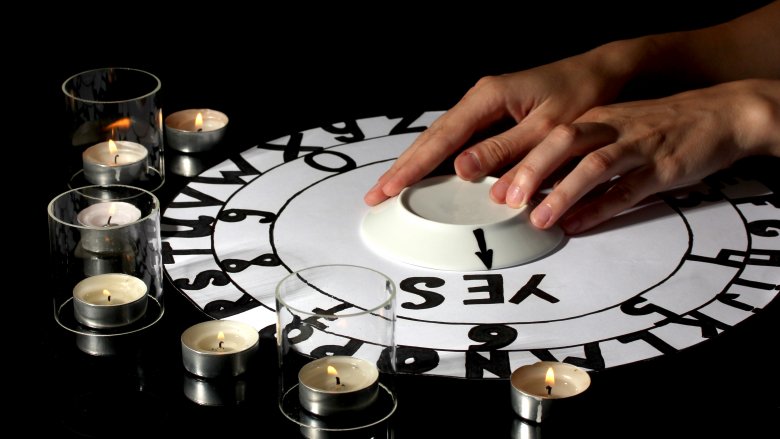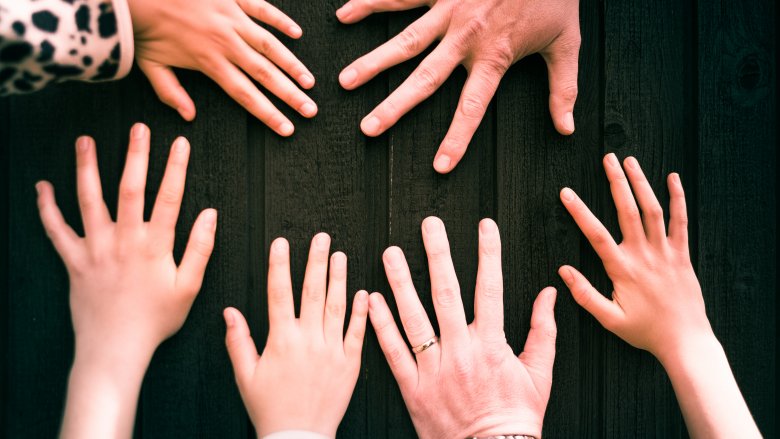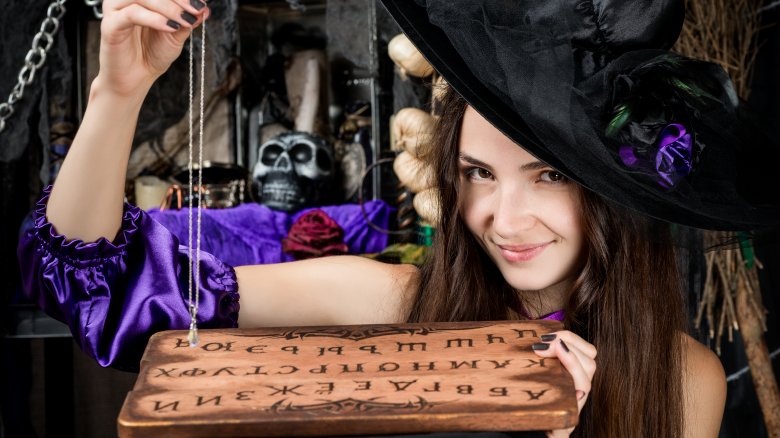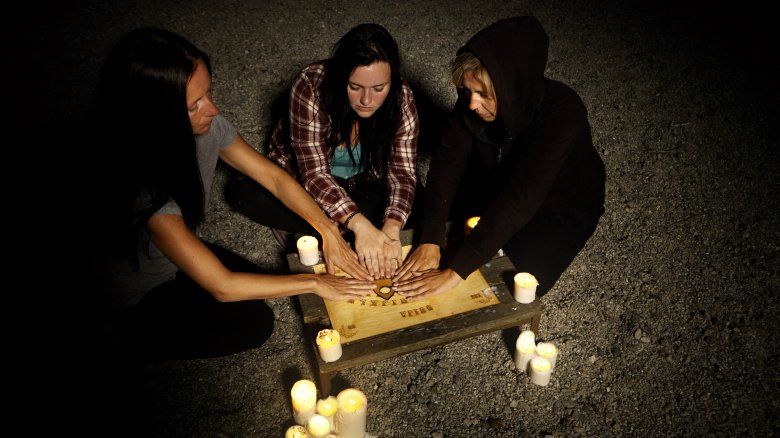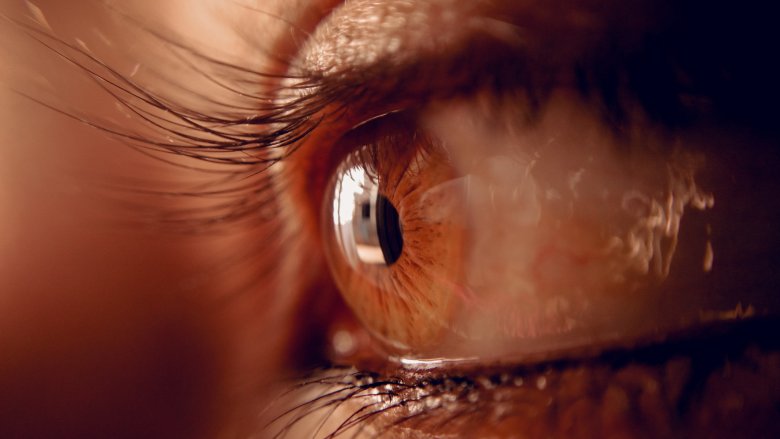The Untold Truth Of Ouija Boards
We all have fun stories about messing around with a Ouija board, whether it was that one night in college, a Halloween party, or that time we actually summoned a demon who spoke Latin and threatened to set us on fire. (That's happened to everyone, right?) It's one of those board games that's fun no matter what you think of it, and it doesn't matter if you think you can speak to the dead or if you just think it's a great opportunity to mess with someone. (Spoiler alert: It is.)
The Ouija board was born from the 19th century's spiritualism movement, and it has a really strange history. It's caused deaths, murders, and feuds, it's destroyed lives, and done some things the biggest skeptics have to admit are a little weird. There's actually a good reason for that, and it has to do with our very own deepest, darkest thoughts. Whether that's more disturbing than contacting the devil, well, that depends on who's touching the planchette, doesn't it?
The original text message
The Victorian era was a strange time, and one of the movements sweeping across Europe and America was spiritualism. It was basically the idea the living could communicate with the dead via seances and things like tapping out messages on the walls. Don't laugh — it started in some grim times, when the Smithsonian says the average life span was under 50 years, and a ton of people went off to war and never came back.
That was the spiritual climate, and historians say the Ouija board was created by some businessmen looking to cash in on people's beliefs, hopes, and need to reach out to someone in the afterlife.
The problem with a seance was that it took a long time to tap out a message on the walls. If only there were a Victorian keyboard that spirits could use to quickly spell out exactly what they were trying to say. Suddenly, there was. In 1886, the Associated Press reported some spiritualists were using a "talking board" in their seances, but it wasn't until Charles Kennard got wind of the story that magic really happened. He gathered investors who were as psyched as he was at the prospect of having this massive market to exploit, and they started the Kennard Novelty Company to become the exclusive manufacturer of the talking boards.
It named itself (maybe)
The popular story is that the Ouija board was named from the words for "yes" in French ("oui") and German ("ja"), but historian Robert Murch says (via Atlas Obscura) it's absolutely not true.
Although there are a lot of conflicting stories, according to the official Ouija board lore he was able to track down, Kennard, investor Elijah Bond, and Bond's sister-in-law Helen Peters were trying to figure out what to call their official talking board, and when they couldn't come up with a name, they decided to ask the board itself. It replied "Ouija," and when they inquired as to what the heck that meant, it replied "good luck."
That's exactly the sort of thing a demon might do to lure you into a false sense of security, but there's still more to the story. Peters — who was something of a medium — was wearing a locket with a picture of a woman and "Ouija" written inside. She claimed she hadn't been thinking of it when the board started spelling, and the name stood. But there's a footnote: Murch thinks the woman in the locket was Maria Louise Ramee, a 19th-century writer and lover of purple stationery and dogs. They may have misread her pen name — Ouida — making the Ouija board a misspelled tribute. It was a nice thought.
A century-long family feud
If you're thinking a guy who would take advantage of the grief of a nation to make a fortune is a little shady, Baltimore magazine says you'd be right. Kennard originally enlisted the help of a furniture-maker turned coffin-maker turned undertaker to make the first board, then cut him out of the company completely. After making his Ouija fortune, though, Kennard cashed out and threw his company to the sharks: his other investors.
One of those was William Fuld. Also in the picture was brother Isaac, and the two brothers embarked on such a bitter feud over the company that after William cut Isaac out of the picture, Isaac went as far as exhuming his infant daughter from the family cemetery and burying her elsewhere. William went on to make millions, but the family wouldn't reunite until Isaac's grandson and William's granddaughter called it off 96 years later.
William's story actually ends with a weird coincidence. He died in 1927, when he was 57 years old. His biography says he was standing atop one of his buildings when the support he was leaning against gave way and he fell. One of his broken ribs pierced his heart. What's weird? He was fond of telling people he'd built the building because the Ouija board told him to. More evidence for the demon angle.
Condemned as a liar
Helen Peters — the medium with the locket — had her family destroyed by the board she helped name, too. Historian Robert Murch came across her part in the story starting with a series of letters published in the Baltimore Sun. They were basically a list of grievances Ouija board investors started flinging at each other, published in the city's paper presumably because the internet hadn't been invented yet, but the human desire for sharing too much information is as old as time itself.
Peters went from being an original investor and working on the patent application to completely condemning the Ouija board as something evil. It started when her family found some of their Civil War memorabilia was missing and decided to ask the board what happened to it. As you can guess, it didn't end well. The board identified one family member as the thief, and while some believed the board, Peters didn't. The following feud tore the family apart. Peters condemned the board as a liar and warned others not to use it.
Heartbreaking wartime popularity
Today, the Ouija board might be something of a party game that people don't take too seriously (or, at least, don't want to admit they take seriously). But it first got popular for a very serious and very heartbreaking reason: the Civil War. Robert Murch says (via Time) that the overwhelming majority of families were touched by the war in some way, mostly by deaths and disappearances. Families wanted to know what happened to their loved ones, and when you're looking for those kinds of answers, you're willing to look anywhere.
"You wrote letters, you waited for a response, and in the meantime, wanted to know if your son or father was okay," says Murch. The Ouija board gave the promises of answers, and even if it didn't actually give those answers, hope was enough to make it popular.
You can't just laugh at our old-timey ancestors, either. Parker Brothers bought the Ouija board in 1966 at the height of the Vietnam War. 1967 was the only year a board game outsold Monopoly.
The original dating game
According to historian Robert Murch (via Time), it wasn't until 1973's The Exorcist that people started making a major connection between the Ouija board and the devil. Reagan uses one to make contact with the demon that goes on to possess her, and the world never looked back. The danger was there, the danger was legit, and other movies tapped into it.
But before that, Murch says the Ouija board had a completely different vibe. It was featured in television shows like I Love Lucy, but it was a vehicle for humor and embarrassment rather than possession. Go back even further, and in between the wars that made the Ouija board popular for another reason, it was actually marketed as a family game particularly suited to couples. Norman Rockwell even painted a couple having a go at the Ouija board, and Murch adds at the time, getting up close and personal on a date wasn't as widely accepted as it is now. It was a brilliant excuse to sit next to each other, touch hands, maybe touch knees, and hopefully not summon the devil. It was such a popular way to send a romantic sort of message, men often bought one for their ladies.
A bizarre witch-murder
The Ouija board has — rightly or wrongly — been linked to a lot of weird stuff. The weirdest might be the strange saga that unfolded in Buffalo, New York, in 1930.
Artvoice says it starts with Nancy Bowen, a Native American healer who had just lost her husband, Sassafras Charlie, and her friend Lila Jimerson, who was working as a model for a French sculptor. Only a few years after moving to the Cattaraugus Reservation, sculptor Henri Marchand's wife, Clothilde, was brutally murdered. Police arrested Jimerson after a witness put her at the crime scene, and she implicated Bowen in the whole messy affair.
Both women confessed, and only part of the reason was Jimerson's plan to get Marchand's wife out of the way so their relationship could become something a little more respectable than an affair. She needed an accomplice, though, and here's where the Ouija board comes in. Jimerson and Bowen held a seance to contact Bowen's dead husband, who they said reached out through the board to claim Clothilde was actually a witch, and she'd killed him. What followed was an insane trial that involved exhuming Sassafras Charlie and lurid testimony from the Frenchman detailing his many, many affairs. Ultimately, The Buffalo News says, Bowen pleaded guilty and got time served, while Jimerson was acquitted. Marchand was outraged, but not so outraged that he left his new, 18-year-old bride home when he had to show up to the trial.
The mystery of Patience Worth
One of the weirdest Ouija board stories is still unexplained. In 1913, Pearl Curran was mucking about with her Ouija board when she contacted a spirit she named as Patience Worth. Worth, she said, was a 17th century poet who not only spoke to her, but wrote through her.
It was a seriously incredible feat, too. Between 1913 and 1917, Curran — whom the Smithsonian describes as "a St. Louis housewife of limited education" — wrote around 4 million words. There were seven books, and a ton of poems, plays, and short stories. Sometimes, she worked on them all simultaneously, with the Ouija board jumping between works without missing a word. Curran (and Patience) toured the country, sitting with the board and turning out original works. Ask any writer — that's a seriously enviable skill, no matter where it comes from.
Curran claimed Patience was an Englishwoman who had come to the future United States in the late 1600s, and she had been killed in a conflict with Native people. At the time, people believed it. The writing wasn't just accurate, but it was factual, it touched on history from almost all eras, and disciplines from botany and historical cuisines to anthropology. Skeptics were charmed, scholars were shocked at the quality of the work, and it still hasn't been entirely explained just how all those stories, poems, and plays came together. Was it her subconscious? Was she a savant? Or ... was Patience real?
There's a demon that lives in there
Mention the Ouija board in certain company and there's a good chance someone's going to warn you about Zozo. The legend says Zozo is a demon who shows up through the Ouija board with a frequency that would be terrifying ... if there really were anything to the story.
The Paranormal Scholar did some digging into whether or not Zozo has any basis in history, mythology, or folklore, and they found he basically starts showing up in earnest in 2009 — the same time an Oklahoma man named Darren Wayne posted a story about Zozo online. The story was a hit, and Wayne ran with it. There have been movies, books, and even more stories about Zozo, so ... what's the deal?
Zozo does, in fact, show up in an 1818 book called Le Dictionnaire Infernal. It's the very book Zozo believers and Wayne point to as proof the demon exists, but there's a big problem. Translate the text from French to English then read the entire thing, and you find the girl who claims to have been possessed by three demons — Zozo, Mimi, and Crapoulet — was taken to a church official who then recognized she was sick, not possessed. She ended up being publicly beaten then imprisoned, and Zozo was called out as a hoax way back then.
So, what's really going on here?
There's actually a pretty cool physiological phenomenon at work here, moving the planchette and spelling out all kinds of weird stuff. It's called the ideomotor effect, and it's basically caused by our body's own minute, imperceptible movements. They're so imperceptible, in fact, that we don't know we're making them and even when it's pointed out to us, we still tend not to believe we're causing it.
According to the BBC, it's the same principle that makes things like dowsing rods work, and it's not just as simple and straightforward as having a case of the twitchies. It brings up an important question about our own consciousness, and it forces us to wonder: How can we be so oblivious to movements we're actually making ourselves, and how can we be completely convinced it's not us at all?
Start looking closely at this, and it's a little mind-blowing. Psychologist Daniel Wegner suggested the phenomenon was proof that assigning ownership to an action is nothing but an illusion, and it's entirely possible to convince the human mind of pretty much anything as far as causality is concerned. That's pretty heavy stuff.
It's creepier (and cooler) than demons
What's creepier than demons from the great beyond? Demons in our very own heads. Science has started to get interested in the disconnect a Ouija board facilitates between our actions and our responsibility for our actions, and it turns out there's something here. In 2014, researchers at the University of British Columbia (via CBC News) blindfolded volunteers, put them in front of a Ouija board, and asked them questions. They found people tended to get questions right about two-thirds of the time, even if they were sure they didn't consciously know the answer.
What's that mean? It's possible the Ouija board can actually give us a way to tap into the subconscious, the part of the brain we're not aware of, by encouraging movements we're not aware we're making. Ever had something on the tip of your tongue, and just can't remember it? It's possible a Ouija board might help.
This fun bit of brain science has the potential to be massively important. Researchers think unlocking some of the secrets here might help us understand what happens to cause things like dementia and Alzheimer's, and it might even allow us to communicate with parts of the brain that are normally off-limits. Pretty nifty, right?
Some stern, 21st-century warnings
The Ouija board may have been invented a good long time ago — back when cowboys were still roaming the Wild West — and even though things like science have come a long way since then, some people still aren't sure what to make of the board's reputed mystical powers. Like the Catholic Church.
In 2014, the church issued some (unofficial) Christmas-time warnings, saying they were worried about people buying well-meaning gifts and accidentally letting the devil into their homes. The Irish Independent spoke with an anonymous exorcist who described the Ouija board like this: "It's like going to some parts of Africa and saying 'I'm personally immune to Ebola.' ... People don't intend any spiritual harm by it, but ... you have no way to control what may impinge on you."
The exorcist added that what most people have learned from movies is absolutely true, he believes. Evil spirits and demons will pose as the dearly departed, earn the trust of an unsuspecting human and then whammo their way into the real world, where it's The Exorcist and pea soup vomit all over again.
Catholic Online (and the tabloid Daily Mail) repeated the sentiment in 2015, calling the Ouija board "a toy modeled after the 'portal of demons,'" which sounds like a great advertising slogan. They said marketing the toy to children was nothing short of irresponsible because there was no telling what they might let into the world. And that sort of explains where reality television came from.
Knock, knock ... is anyone there?
Mankind has been looking for a way to find out what's happening on the other side for a long, long time, and the Ouija board isn't the first tool developed to try to facilitate communication. It was efficient, sure, but mediums, spiritualists, and people just looking for answers had other ways of trying to speak to the dead pre-Ouija.
One of the most tedious methods had to be something called "alphabet calling." According to the Conversation, the method was a favorite during the early days of the Spiritualism movement, and it basically involved someone literally calling out the alphabet. When the person got to the letter the "spirit" wanted, there would be a knock to tell the living to write down that letter, then start the alphabet all over again.
Tedious, sure, but it was also pre-Netflix, and you can only fill so many hours with knitting socks.
Automatic writing came not long after that, where a person would drift into a trance, channel a spirit, and allow them to write through their own hand. Interestingly, history knows exactly where the idea for Ouija board-like communications started. In 1853, spirits at a seance led by Allan Kardec requested people turn a basket upside-down over a piece of paper and stick a pencil through the bottom. They all put their hands on it and guided the writing that way. Interdimensional communication never looked the same again.
As proven at the Patent Office
Early Ouija boards were brilliantly marketed as having been proven to work in front of U.S. patent officers, and just how that all went down was even more brilliant.
Charles Kennard was the mastermind behind the official version of the board, and when he decided to start making and selling them to the masses, he recruited some investors — including local attorney Elijah Bond. When it came time to apply for a patent, Bond proved worth his weight in gold.
The U.S. Patent Office wouldn't give them a patent unless they could prove it did exactly what they said it could do, specifically, commune with the spirit world and uncover knowledge that they shouldn't have known. So Bond and his sister-in-law, Helen Peters, went before the patent officers to give them a demonstration. The chief patent officer was there, and he had never been introduced to either of them. If they could get the board to spell out his name, they would get their patent.
So they sat down, asked the board his name, and it dutifully spelled it out for them. The officer was, by the Smithsonian's accounts, more than a little freaked out. It's not like they could have just Googled his name, after all, and he awarded them their patent.
There's a footnote to the anecdote. Bond, the attorney from the story? He was also a patent attorney, and surely would have known the name of the head of the patent office, even if they hadn't met. It was a simpler time.
The award-winning work written via Ouija
James Merrill was born in 1926, and when history talks about well-to-do poets born with silver spoons in their mouths, he was up there as the son of the co-founder of Merrill Lynch. Merrill was given a Ouija board as a birthday present in 1953, and when he sat down and tried it with fellow writer David Jackson, magic happened.
According to Yale Alumni Magazine, Merrill and Jackson spent decades collaborating via Ouija. They made their own board, chatted with deceased friends, and came across a spirit guide named Ephraim. Ephraim had lived in the court of Rome's emperor Tiberius, and in 1976 Merrill published a long poem based on their conversations.
After The Book of Ephraim, Merrill started channeling new spirits who warned of the end of the world and nuclear annihilation. The same spirits started telling him all about true spirituality, the creation and the fall, and even started describing some weird, weird creatures like "a hornless unicorn."
"That's just a horse!" cynics would cry, but no one gets to be an award-winning poet with that sort of attitude. The messages were turned into a massive, 560-page poem, published as The Changing Light at Sandover. It all sounds pretty weird, but critics loved it. The tome was awarded the National Book Critics Circle Award in 1983, says the New York Times, and Merrill himself could also claim a Pulitzer Prize and two National Book Awards. Hopefully, he at least thanked the spirits.
Nothing like an old-fashioned book-burning
No high school student actually wants to read the majority of the classics that get shoved down their throats (looking at you, Mr. Shakespeare), but few would organize a large-scale book-burning to get the point across. Which is a little strange because according to Forbes, book-burnings were once insanely popular. At the turn of the 20th century, they were led by Anthony Comstock and the New York Society for the Suppression of Vice, a group that was probably not the least bit fun at parties.
Sure, that sounds right for archaic, turn-of-the-century beliefs (and a bit of Third Reich insanity), but the Christ Community Church in Alamogordo, New Mexico, was doing it in 2001. At the heart of their book-burning was Harry Potter, but they were also burning Stephen King's books, Disney's Snow White, AC/DC albums, and a ton of Ouija boards (via the BBC).
Weirdly, Pastor Jack Brock claimed it was all part of Christmas, and it was the church's way of destroying potentially dangerous gifts that would allow unsuspecting children to commune with the devil or develop their occult skills while turning them away from God. Merry Christmas?
Wait, we've known about the science behind it for how long?
The scientific explanation for why the planchette moves is less about spirits and more about involuntary movements of the human body. (Which, to be fair, is equally terrifying.) The so-called ideomotor response is behind not just making people think they're talking to a spirit through the board, but Skeptoid says it's also why someone might unconsciously try to press RT+Y while they're driving down the road after an all-night gaming session.
MIT says people have known about the ideomotor response for a long time. Michael Faraday started investigating spiritualism and the involuntary responses people demonstrated during seances back in the 1850s, and in 1853 he set up an experiment proving people were the driving force behind the supposedly supernatural phenomenon they were seeing. His proof came a year after Dr. William Benjamin Carpenter named the phenomenon and guessed it had something to do with the interaction of the muscles, the nerves, and the emotional side of the mind. That's decades before the Ouija board was even a twinkle in anyone's eye.
Faraday's work was publicized, too, when fellow scientist John Prichard wrote of the phenomenon in a pamphlet, set off a feud with Faraday, and lamented the fact that "the public will not readily give up its plaything" all in one go. People using the Ouija board may have heard that it was them all along, but belief, hope, and love are powerful things.
People who really truly are hurt by it
A weirder-than-usual story hit Cosmopolitan in 2014, and it was the tale of three friends who ended up in the hospital after being — reportedly — possessed by spirits from the Ouija board. The friends (who ranged in age from 18 to 23) said they suffered from things like hallucinations, blindness, muscle spasms, and sensations of numbness, while one seemed to slip into a trance. Reports say they were behaving so bizarrely it was almost impossible to get them to a hospital, but they did eventually recover.
A similar story hit headlines in 2015 when an 18-year-old Peruvian girl came down with a case of possession after playing with a Ouija board app on her phone. The medics who treated her claimed she seemed to have abnormal strength, was foaming at the mouth, lost control of her actions, and her voice changed, according to the Australian Broadcasting Corporation.
Right, so what's going on here? According to Psychology Today, it's not unheard of to see people falling into a "possession state" after mucking about with a Ouija board. Those two cases are just a few of the slew of reports of people — usually teens — falling into a possession-like state. While the mechanics aren't 100 percent clear, it's believed a combination of stress, anxiety, and a cultural belief in the ability to summon demons and evil spirits can combine to trigger a very real reaction in particularly susceptible and highly suggestible individuals. Sometimes, the demons are in the mind all along.
It's easier to believe when everyone else does
Take even the staunchest of cynics, sit them down around a Ouija board with some friends, light some candles, and wait for it to start spelling out some cryptic messages. Even that cynic will probably have a few moments of "Wait a second ... hold up ..." and that's because the whole experience can be a pretty powerful thing — especially when there are believers in the group.
The board has always been advertised as something done with a group of people because that's how it works best. Part of the mechanics, says the Smithsonian, is that Ouija boards (like dowsing rods and pendulums) take small, involuntary movements and magnify them. The more people, the more movement. Dr. Chris French of the University of London adds that it's easier for people to believe in a group setting. Say there are five people sitting around a table, their minute movements are magnified, and every single one of those people can deny they're the ones moving the planchette. What other explanation can there be, but spirits? Suggestion and belief are powerful — and contagious.
Denial: It's not just a river in Egypt
But surely, people have to know they're moving, right? Human bodies are incredible things that can feel everything down to the slightest brush of a feather to the smallest stone in the shoe, so how can they be so completely, 100 percent convinced they aren't moving the board?
Researchers from Aarhus University (via the British Psychological Society) have mapped out just how people can be so convinced they're really not moving the planchette at all — honest. They gave participants a board and first asked them to spell out certain words. Researchers tracked their eye movements and found that people tended to look at the place they're moving the planchette to as they spell. No surprise there, right?
Then they had the participants use the Ouija board normally. Since they didn't have the words in advance, it was much, much more difficult for them to predict where the planchette was going to move and to look there. That lack of anticipatory eye movement meant participants' brains weren't predicting their own movements, which translated into a feeling of "less ownership" over those very same movements. It's essentially a schism between the conscious and the unconscious. Because we can't predict what our unconscious mind is going to do, the rational mind denies agency in the whole matter. Pretty convenient, isn't it?
